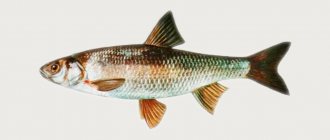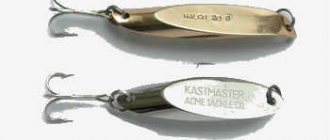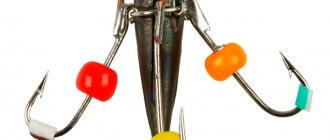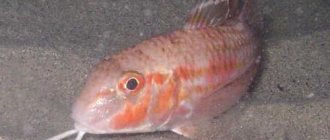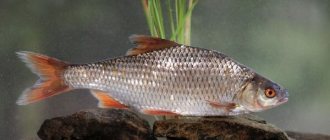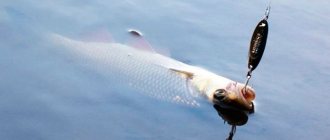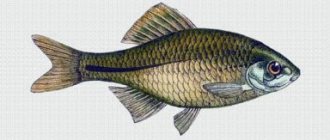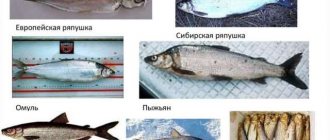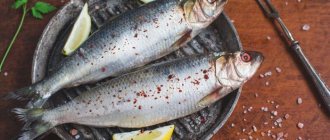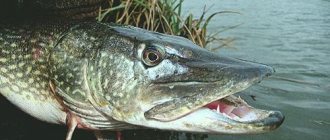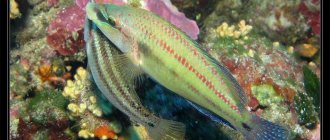Mackerel is popular among fishermen not only due to its behavior when hooked, but also due to its gastronomic value. Dishes made from it are tasty and healthy, and fishing for it is full of excitement. A strong fighter with a tireless character often becomes his own prey.
How to find the habitat of one of the largest representatives of mackerel - the Spanish mackerel? What natural phenomena-signs should you pay attention to when hunting this predator? How to curb and what gear to use, how to equip them and which fishing tactics to use. You will find answers to all these questions from this article.
Content
- 1. General description of fish
- 2. Distribution and habitats
- 3. Age and size
- 4. Lifestyle
- 4.1 Reproduction - time and characteristics of spawning
- 4.2 Diet - what to eat
- 5.1 Biting calendar - what time of year and day is the best time to bite?
- 5.2 What weather is the best time to bite?
- 5.3 What are the best places to fish?
- Some fishing spots in the Mediterranean Sea
- 5.4 What gear is best to fish with?
- 5.5 Bait for fishing
- 5.6 What baits and baits to fish with
- Animal attachments:
- Artificial baits
https://youtu.be/https://www.youtube.com/watch?v=DWz7m4B2oWA
Recreational mackerel fishing
Mackerel (mackerel) has a spindle-shaped body, the head of the fish has a conical shape, the tail is thin, the middle of the fish's body has maximum thickness. The maximum size of mackerel is 60 cm, and the average length of the fish does not exceed 30 cm. Large individuals can reach up to 2 kg, but rarely exceed 1.5 kg, but most individuals weigh 250-350 grams. There are 4 main types of this fish - Atlantic (common), Japanese (blue), Australian and African.
All types of mackerel have a silver body color, there are dark stripes across the body, and the back of the mackerel is blue-green. African mackerel is considered the largest. She is a little different from her relatives. First of all, the size. Its dimensions can reach 63 cm, with a weight of more than 2 kilos. The smallest is the Japanese mackerel, the maximum size of which is no more than 45 cm, and the largest weight is 1,250 kg. The Atlantic mackerel can be distinguished separately; unlike its other relatives, this species does not have a swim bladder.
Fishing for mackerel is possible in many places on the planet; its habitat is huge. Mackerel is absent only in the Arctic Ocean. Atlantic mackerel often swim into inland seas. Baltic, Marble and Black. Off the coast of Europe it is distributed from Britain to the Canary Islands.
Mackerel is a migratory fish, as it can only live in temperatures of at least 8°C. Only mackerel winters in the same place where it lives permanently in the Indian Ocean, where it has the most optimal temperature conditions. In winter, the common mackerel migrates from the Black Sea to warm currents to the coast of Northern Europe. Only a small part of it remains to spend the winter off the coast of Turkey, or it migrates entirely.
In wintering areas, the fish are inactive and practically stop feeding and stay near the continental shelf at depths of 200-300 meters. Mackerel migrates back to the Black Sea after spawning in late spring or early summer.
The main source of food for this predatory fish is zooplankton and small fish. Mackerel gathers in large schools and begins to hunt for prey. She hunts mainly for Black Sea sprat, gerbil, and anchovy. Mackerel attacks schools, pushing small things to the surface of the water, it turns out something like a “perch cauldron”.
The most voracious is the Australian species; according to Australian fishermen, mackerel rushes even on an empty hook, since it considers everything it can swallow as its prey. Therefore, many consider the best tackle for fishing for mackerel to be a tyrant.
Fishing for mackerel is not particularly difficult, but you need to prepare for it in advance. The gear for catching it is quite unpretentious. However, some anglers like to catch mackerel using the fly fishing method, which allows them to cast their tackle far. It is better to catch mackerel from a boat or yacht.
Anything bright and catchy is suitable for baiting mackerel; the hooks are decorated with silver foil or colorful feathers. Their main task is to attract greedy mackerel. It is best to equip a match rod with such equipment with several leashes. Before casting, you should determine the depth of the bottom, so that you can then correctly cast.
It also happens: Catching rotan with a float rod: tackle, bait and fishing technique
Of course, mackerel can also be caught using natural bait, cut fish meat, shellfish meat, and small fish. But why complicate the task if mackerel can be easily caught using artificial baits that you don’t need to buy; you can make them yourself without any problems. However, the tyrant is inexpensive on the market and if you are too lazy to do it yourself, you can just go and buy it at a reasonable price.
This method of catching mackerel is perhaps the most common in the Black Sea. If you are afraid that the sinker of your tackle may get caught on something at the bottom, then do not allow it to sink to the very bottom. As soon as the main line is in the water, you should immediately start working with the fishing rod and tighten the line. This technique is not difficult, but the result in the form of a large mackerel will be obvious.
Also, you should not make more than 4 leashes. Of course, with more mackerel hooks you can catch more mackerel. But you will lose more time unraveling them, so you should not be greedy. If you choose the right place and there is a lot of mackerel there, using gear with three leashes, you can get a rich catch. This type of gear mounted on a match rod is used to fish from the shore or pier.
You don't need a long rod to catch mackerel from a boat. But here you need to take into account the direction of the wind and you must be able to cast from the back, in which case the sinker will accurately hit the target. You also shouldn’t play for a long time and you need to periodically change tactics, playing off the line in different ways. Since mackerel is a fish that never stands in one place, you may have to put some effort into finding it.
In some cases, the mackerel may be in the current; in this case, the sinker clings more heavily so that it is not blown away from the bottom. When fishing for mackerel, the effect of breakers is required, otherwise you may be left without a catch.
As for the taste of mackerel, it is probably unnecessary to talk about them; most people already know that this fish is excellent both smoked and marinated. And freshly caught mackerel is doubly tasty.
general description
The most striking representative of mackerel, which is represented by numerous species. Spanish mackerel is what this fish is called in English-speaking countries.
Spanish mackerel have a graceful elongated (torpedo-type) body and an elongated head. Narrow, pointed teeth line the oral cavity. On the back there are located, at a short distance, two fins, which have a sufficient number of spiny rays. There are small soft fins on the belly.
The back color is gray with a blue tint. The sides are silvery (steel) with spots, and the belly is greenish.
Mackerel fish. Mackerel lifestyle and habitat
Features and habitat of mackerel
The mackerel fish, otherwise called mackerel, being a relative of the perch, belongs to the order Perciformes. The average body length of this aquatic creature is about 30 cm, but in nature there are often individuals more than twice as long, reaching a weight of up to 2 kg.
However, small specimens can weigh only 300 g. The head of the fish has the shape of a cone, the body is shaped like a spindle, covered with small scales, in the tail part it is thin and laterally compressed.
The body color is silver, marked with dark transverse stripes, the back is greenish-blue. In addition to the usual dorsal and pectoral fins, mackerel has five rows of additional fins, of which the caudal one is widely forked.
Like many representatives of the mackerel family, in such a fish it is possible to distinguish a bony ring around the eyes. The snout of these aquatic animals is pointed, the teeth are conical and small in size.
Mackerel are divided into four main varieties. Among the species of mackerel, African ones reach the largest sizes. The length of such individuals can be equal to 63 cm, while the weight can exceed two kilograms.
It also happens: Nod for fishing from a boat
The smallest (44 cm and 350 g) is the blue or Japanese mackerel. In addition, the following types of such fish are known: common Atlantic and Australian.
Mackerel occupy an oceanic territory that has spread to all parts of the world except the Arctic Ocean. Schools of such fish swim into various seas, for example, they migrate to the waters of the White Sea, and mackerel also lives in the inland depths of the Baltic, Marmara, Black and other seas.
Character and lifestyle of mackerel
Mackerel is one of the fish that does not spend most of its life close to the bottom, but swims in the pelagic zone. These are excellent swimmers who thrive in the aquatic environment and are adapted to an active life in the depths of salty reservoirs.
And an extensive set of fins helps them avoid whirlpools when moving rapidly. These fish live in schools, often joining groups with Peruvian sardines. The mackerel has a lot of enemies in the water and air, and pelicans, sea lions, dolphins, sharks and large tuna can pose a danger to it.
Mackerel are a type of fish that feel comfortable only in the temperature range of 8-20 °C, for this reason they make annual seasonal migrations.
And all year round, these fish have the opportunity to live only in the warm waters of the Indian Ocean, where the temperature regime suits them quite well. The comfort of Turkish waters does not completely satisfy them either, so the mackerel inhabiting the mentioned waters rarely stays to spend the winter in their native places.
When cold weather sets in, mackerels living in the Black Sea move to the north of Europe, where there are warm currents that provide them with the opportunity to live comfortably. During migrations, mackerel are not particularly active and do not spend vital energy even searching for food.
The absence of a swim bladder and developed muscles help the Atlantic mackerel move extremely quickly in the water, which is also greatly facilitated by the spindle-shaped body structure.
Such fish can reach speeds of up to 30 km/h. This ability to move quickly helps these aquatic creatures carry out long migrations, traveling long distances.
Mackerel nutrition
Mackerel are typical aquatic predators. They feed on plankton filtered from the water and small crustaceans. Mature fish choose squid and small fish as prey.
When attacking its prey and making a throw, the Atlantic mackerel, for example, in a couple of seconds is capable of developing an instantaneous speed of up to 80 km/h.
For hunting, mackerel gather in schools, and the objects of their attacks can be sandstones, anchovy and sprats.
A school of mackerel, acting together, forces its victims to rise to the surface of the water and, having thus driven their food en masse into a corner, proceeds to a hearty meal, which is often joined by larger aquatic predators, seagulls and dolphins. Observing such a gathering from above, it is easy to spot the mackerel's feeding area.
These small sea predators are quite voracious, but the Australian mackerel has the most brutal appetite. She is ready to grab, without much hesitation, everything that seems edible to her. Due to this feature, Australian fishermen often enjoy the fact that they can easily catch mackerel even on a hook without any bait.
Reproduction and lifespan of mackerel
Mackerel begin to spawn in the second year of life. And then, every year, mature individuals are able to produce offspring until they reach the most advanced age, which for this fish occurs at 18-20 years. This age is the lifespan of such organisms.
More mature fish begin spawning in mid-spring. Young mackerel begin the reproduction process only towards the end of June. Sexually mature individuals spawn in portions in coastal waters throughout the spring-summer period.
Mackerel breeding is quite active, as the fish are extremely fertile, leaving up to half a million eggs at a depth of approximately 200 meters. The diameter of the eggs is only about a millimeter. And each of them is equipped with a drop of fat, which will provide nutrition for the developing offspring.
The duration of the formation of larvae directly depends on comfortable conditions in the aquatic environment and ranges from one and a half to three weeks. Mackerel larvae are so carnivorous and aggressive that when they are thirsty and have a good appetite, they are able to eat each other.
The newly born fry are small, only a few centimeters long. But they grow quickly and by autumn their size increases three or more times. But after that, the growth rate of young mackerel slows down.
Mackerel fishing
Mackerel is a fish that has always been highly valued and has been the object of active fishing. It is worth mentioning that up to 65 thousand tons of such fish are caught annually on the western European coast alone.
It also happens: Hood for winter fishing: we make it with our own hands
The extensive habitat of mackerel makes it possible to catch it in many corners of our planet: off the coast of Europe to the Canary Islands, in the Black, Baltic and Marmara seas, and in the summer in the north in Iceland and on the coast of Murmansk, in the waters of the White Sea, off the coast of Novaya Zemlya and in countless other places. For mackerel fisheries, purse seines and steel seines are most often used, as well as trawls, longlines, a variety of fishing hooks and gill nets.
Fishing for mackerel does not seem particularly difficult for avid fishermen. And the most convenient way is to catch from a yacht or any boat. This is a fairly greedy fish, so luring mackerel is a very simple matter.
Anything catchy and bright is quite suitable for this, and fishermen, knowing this, often equip the hooks of fishing rods with all sorts of shiny specks and silver foil. As bait, you can use small fish, shellfish and fish meat, as well as artificial bait, which can be freely purchased.
Mackerel is a delicious fish, its meat is smoked, salted and canned, but freshly caught it will taste the most wonderful. This product is relatively inexpensive. The price of mackerel directly depends on its quality and ranges from 120 to 160 rubles per kilogram.
How to cook mackerel
Mackerel is a fish that plays a significant role in the food industry. And it has a special place in cooking, since mackerel is a healthy fish.
The fat content of the meat of these aquatic animals is quite high and reaches 16.5%, and therefore such fish dishes, due to the presence of fatty acids, are highly nutritious.
In addition, mackerel meat is tasty, tender, does not contain small bones, so it is easily separated from them, and is rich in easily digestible protein and vitamin B12.
Mackerel meat is a noble variety. There are more than enough wonderful dishes that can be created from this fish. And a huge number of recipes with mackerel that are useful in everyday life and for the holiday table have been invented.
Such meat is baked in the oven with vegetables, marinated, made in batter, poured with a wide variety of sauces, stuffed with delicious fillings, cutlets are fried and pates are prepared.
However, this product also has some features. The fact is that the smell of even fresh mackerel is quite specific. That is why skillful housewives, in order to create tasty mackerel dishes, have to resort to some tricks.
Before cooking, the meat of this fish is most often marinated in dry white wine, vinegar, lime or lemon juice to remove unwanted odor. For the same reason, it is also possible to sprinkle fish meat with fragrant herbs.
Mackerel fillet is easily divided into semicircular layers. This meat should be baked, wrapped in foil. Fried and boiled mackerel has the disadvantage that it turns out a little dry, as it easily gives off the fat it contains. And this is another reason to marinate its meat before cooking.
The mentioned product is best used fresh. And it is extremely undesirable to use mackerel that has been frozen for the second time. In the latter case, the fat contained in the meat may turn rancid. And a sign that this has already happened are yellow spots appearing on the carcass.
Lifestyle
The main condition for a safe stay is the water temperature, which should be between 8 and 20 degrees Celsius. Mackerel waits out the winter period at a depth of about 200 m.
4.1 Reproduction - time and characteristics of spawning
The spring period is the spawning period for representatives of these fish. Females are fertile and are capable of hatching up to a million eggs at a time, measuring about 1 mm. However, only a small proportion of the fry survive.
4.2 Diet – what does Spanish mackerel (palamida) eat?
A true gourmet, he eats anchovies, squid and other delicious representatives of the aquatic world. Seeing a school of small prey, the mackerel grabs it. With sharp movements of a strong body and a powerful tail fin, it stuns other fish, which disorients them in the water space. The predator will not stop until it destroys all the fish in its field of vision.
How to Catch Spanish Mackerel (Plus Free PDF Fishing Card)
It's time for Spanish mackerel!
Insider contributor Daniel Flynn is back with another great how-to article and PDF card.
You may recognize Daniel Flynn from some of his other articles here:
This time he is teaching us all how to catch Spanish mackerel.
You will learn:
- When and where to find them (plus telltale signs they're nearby)
- How to get the bait for the maximum number of strikes
- The gear (and the specific type of leader) to use so you can take more gear with you on the boat
- Why They Make Great Family Fishing Targets
Enjoy and don't forget to download your free PDF catch chart here !
Spanish mackerel
Scomberomorous Maculatus
Where:
- Offshore in open waters around a structure
- In coastal waters in open waters, including flats and oyster bars
- On the shore near the surf and piers, especially in warm weather
When:
- From March to September
- As the water warms, they will move closer to the shore
Equipment:
- Light to medium spinning or bait casting tackle preferred
- Medium and strong fishing rod from 7 to 8 feet
- 12-20 lb braided line
- 30-40 lb fluorocarbon leader; steel leash in case of loss of tackle
- 1/0-2/0 circle hook to match bait size
- Bobber, especially one that attracts intermittent retrieval.
Bait:
- Minnows, mullet, mullet
- Cut baits such as squid
- Live or dead shrimp cut onto hook
Lures:
- Shiny spoons, heavy metal lures
- Plastics with jig heads - something bright or colorful that can be reeled in quickly
Tactics:
- Look for diving terns and pelicans or bait being driven to the surface
- Drift in the area to spook the mackerel
- Quickly get the shiny bait
- Try changing the extraction depth and speed
- Use a steel leader if the fish cuts the line too often
- When fly fishing, use colorful flies that imitate minnows
- Sight fishing is one of the best ways to find these fish.
Trends:
- Spanish mackerel begin to move from deeper offshore waters to coastal waters in March
- When the water begins to warm above 70 degrees, they move to shore where anglers can catch them from piers and the beach
- They usually travel in large flocks and are constantly moving in search of prey
Community:
- Almost everyone, from marina staff to anglers, will tell you where the Spanish mackerel are.
- Boats often follow schools and congregate where fish are being caught. Be sure to leave plenty of room for other boats as a courtesy.
- Check the fishing section of your local newspapers and magazines. Scan online fishing reports, such as those posted by Fishin' Franks in Southwest Florida.
Spanish mackerel!
Daniel Flynn
Blink twice and you'll miss this speed demon from Florida waters.
The spool in the line is neatly cut next to the leader and, you guessed it, another Spanish mackerel.
Although they are not always valued for their nutritional value, this slender, colorful and powerful species is an excellent fighter and is certainly worth the effort.
There are a few helpful tips to consider before targeting this species.
When and where
From March to September, when you see these birds, especially little terns, diving into the water for bait, it is likely that Spanish mackerel are bringing the bait to the surface.
Pelicans can also join the fight.
Since Spanish mackerel travel in large schools, there will be quite a bit of noise on the surface of the water.
In the spring you will meet these brave fighters on the high seas, and then summer comes in all bays and inland waters.
They may be on the open flats or hanging around oyster bars with bass or spotted trout.
In the warmest weather they are caught near the shore.
Keep in mind that these fish are hunters.
They don't sit idle like flounder and wait for the bait to pass.
They search and destroy, often sending out "scouts" in search of prey.
Once they find their potential meal, they surround their prey and go for the kill.
Epic Spanish Mackerel Fishing [VIDEO]
Tackle and equipment
Depending on the size of the Spanish mackerel, your equipment can range from a light to medium 7-foot rod to a heavier 8-foot rod. a rod centered in the middle of the rod, not necessarily at the end.
A medium sized reel or a regular even wind reel will work equally well.
Mackerel feed on the move, so you need to be ready for a fight from the start.
Many anglers prefer to use a fairly thick fly rod for this species, especially with streamers that give the appearance of a fast-moving lure.
Braided line is best for casting, and higher grade fluorocarbon can prevent mackerel from constantly cutting the line.
However, be sure to bring a wire leash with you.
If you start losing fish, you'll need to switch to a line leader before you lose too many rigs.
As always, circle hooks are recommended for all Florida fish as they are less likely to snag and kill the fish you would normally release.
Haywire Twist Fishing Knot (Wire Leader) [VIDEO]
Bait & Lures
Spanish mackerel will eat anything including sardines, mullet, cut fish, squid and shrimp.
They prefer fast-moving bait, but are not particularly picky when feeding.
Experienced anglers will always have shiny spoons and other heavy metal lures on hand.
Some even boast that this species attacks a bare, shiny hook with nothing on it.
They will take top or bottom baits, so it's best to try different baits if a silver spoon isn't producing results.
Also try varying your retrieval depth as these fish can be found anywhere in the water column.
Start with a fast search and then slow it down.
Other artificial baits that work well include Gotcha, spinner baits, and plastic baits with jig heads.
If you decide to use plastics, keep plenty of them in your tackle box as Spanish mackerel will tear them apart quickly.
Whatever you use, remember to keep it colorful and easily searchable.
Spanish mackerel for dinner
Spanish mackerel is easy to clean and produces excellent fillets.
There are plenty of recipes for preparing this type of fish, and many fishermen like to smoke this fish.
They can be a little oily, but can be quite tasty when cooked correctly.
Catch, clean, cook and eat! Spanish Macras [VIDEO]
Fishing for the whole family
Because Spanish mackerel are easy to catch, they make an excellent target for family fishing.
Take the kids with you and let them enjoy the fight these fish provide.
Watch for diving birds, boiling surfaces, and boats congregating around a particular area of water, all of which indicate these fish are on the prowl.
Conclusion
I hope you enjoyed Daniel Flynn's article!
If you want to catch Spanish mackerel this spring, summer or fall, keep these tips in mind:
- Use light to medium spinning equipment
- Beware of diving birds or bait boiling on the surface
- Find them in offshore structures or coastal areas on beaches, piers and shallows near open water
- Vary the speed and depth of your search to find the meeting place
- Use live bait, silver spoons, Gotcha plugs or similar bait... when they eat they aren't too picky!
- Use a steel leash if they cut you off
Feel free to download the free PDF catch card here
so you can save it to your phone or print and laminate it to take with you on the water.
P.S. Have a question for Daniel?
Ask him in the comments below!
FREE GUIDE
"Coastal Fishing Manifesto"
Three important steps to consistently catching coastal strikes faster than you ever thought possible.
Get your free copy here
.
How, where, when and what to fish for Spanish mackerel
Fishing for this predator is successful all year round. No special natural favorable moments are required to catch mackerel.
5.1 Biting calendar - at what time of year and day does palamid bite best?
You can fish from spring until cold weather. When fishing on shore, the ideal time would be the spring, when the fish are actively feeding near the shore.
5.2 What weather does Spanish mackerel bite best in?
In bad weather with waves of low height, I fish far from reef areas in the area of deep-water channels. Focus on the time of ebb and flow, when schools of small fish are carried by the current.
Watch out for the birds, they are the ones who will show the accumulation of fish. If birds are not visible, then dark spots (between the reefs) on the water will indicate the presence of small fish. On a sunny day, the spots look bright and silvery.
5.3 What are the best places to catch palamid?
Representatives of these fish are found in places with changes in depth, whirlpools, where a large variety of food for this fish is concentrated. However, due to their rather large size, these fish also love open waters, performing rapid maneuvers there. The fish can also be found in rocky areas and coral reefs.
5.4 What gear to use for catching Spanish mackerel
Option 1 – very expensive Spinning SMITH GTK-73SL up to 80 g;
- Stella 6000 coil;
- cord;
- in the “blind” mode, metal leashes with a length of 30 to 40 cm are attached to the bait ring;
- The cord and leash are secured with a carabiner (for example, Cross lock Bearing Swivel No. 4);
- “Owner” tees 1/0, 2/0, 3/0;
Advice:
- The speed control mechanism in the reel should be slightly loosened. You can check by tugging the cord and if it comes off the spool with difficulty, then good, and this will save you from a possible break;
- Do not use a black or dark colored rifle, the fish will turn away from them!
Option 2 When fishing from the shore, use a float rod with a sinker from 50 to 80 g and 3 or 4 leashes. The sinker should not be lowered to the bottom, as soon as it approaches it - do the wiring.
Option 3 Float rod:
- spinning reel;
- fishing line
- float
Float mount
The fishing line is threaded through a bead located on top and driven to the stop knot. Next, a fishing line is threaded through the center of the float. Another bead is installed under the float, behind which a weight is attached (heavy to hold the float in a vertical position), then a hinge. A 30-centimeter fishing line is attached to the hinge, and an Aberdeen hook No. 1 is attached to its other end. (see picture below)
Method of attaching a float and equipment for sea fishing from the shore
5.5 Bait for fishing
Any sea fish is used as bait.
5.6 What baits and baits do Spanish mackerel (palamida) bite on?
Animal nozzles
- small sea fish (garfish, sea pike (molva - Molva has an elongated body up to 1.8, less often up to 2 m, and weighing up to 40 kg), herring) no more than 30 cm in length.
- fish slices;
- baby
Artificial baits Walker (walker, walker, walker) is a universal bait. It performs well during fast retrieves during waves.
Basic requirements for bait:
- length from 14 to 20 cm;
- weight from 50 to 80 g;
- faded silver color with hologram;
- the best representative of walkers Baby Runboh 14.5 cm with dough 69 g.
Wobblers. Should be taken for shallow water, floating with a depth of up to 2 m. Basic requirements:
- length from 14 to 25 cm;
- animation and sound balls (this indicator is necessary to catch a trophy specimen that is guided by sound);
- the best representative of wobblers is from the manufacturer SMITH Saruna 147 MAX, Saruna Slim, from the manufacturer HALCO wobblers Laser Pro 185.
Sliders - suitable for guiding in reef areas and waves. Can be used when trolling at a speed limit of no more than 6 km/h. Example of a suitable HALCO Giant Trembler Jig/Deep Troll or Max model.
Jig spoons work well when casting. Apply weights from 40 to 80 g and flat shape!
The “sea tyrant” tackle is used in three types:
- playing (performs well at sunrise and before sunset, as well as during daytime fishing in calm weather);
- conspicuous (multi-feathered and bright, suitable for daytime autumn fishing in clear water);
- mixed (consists of a bright feather and black sheepskin threads with large hooks).
In this design, the distance between the hooks should be from 30 to 60 cm. When fishing in the dark and in opaque water - from 25 to 35 cm, in clear water in the daytime - 40 - 60 cm. The lower hooks (2-3) are tied to a fishing line with a diameter of 0.20 - 0.25 mm. The length of the tyrant is up to 8 m.
5.7 How Spanish mackerel or palamida bite
The bites are strong and greedy. This moment of hooking cannot be missed, as in the next minute it may spit out the bait. When catching medium-sized fish, you should use a jig spoon with a small hook. When biting, trying to escape from the tee, the mackerel pirouettes in the air, jumps out of the water and can fly over the boat.
5.8 How to fish correctly. – Basic techniques.
- When fishing with range gear, I fish with baits weighing from 40 to 80 g.
- Casting with a spinning rod is done at arm's length, so that it is parallel to the water surface. For safety, the tip of the tackle with bait should be over the side of the vessel. The hand holding the rod should drop sharply down, then stop, so that an angle of 45 degrees is formed. The bait should be positioned along the edges of the school so as not to spook the fish. The nature of the wiring depends on the bait. So, walkers and wobblers should be driven quickly, sliders and spinners - quickly. In this case, the wiring of spinners and walkers should be done with the tip of the rod lowered, which will make the bait more sweeping.
- If a predator bites, but breaks away, you should change the bait and install a smaller tee.
- You should know that large (trophy) individuals never live in flocks, they are solitary.
- The trolling method of fishing is carried out at a speed of at least 5 or 6 km/h. With this method, you need to look for schools of small change, since the mackerel will be there.
- Before casting match gear equipped with several leashes, you should first check the depth in order to carry out the correct casting.
Fishing is best done with an assistant. When lifting fish onto the deck or shore, strictly observe safety precautions, since the fish fights to the end and fiercely for its freedom.
Mackerel with a length of 1.2 m to 1.5 m, before capturing the bait, they try it, biting several times. Under such circumstances, continue wiring without cutting. Once the fish has taken hold, you should wait until it gets tired of the resistance. Next, slow down the spool and fish quickly. At such a moment, the mackerel may rush under the bottom of the boat; to avoid this, it is better to slightly loosen the tensioned cord and let it feel free, then it will rush back to the open surface of the water. After she has calmed down a little, continue fishing. As soon as it is 2 m from the vessel, complete the fishing process with the help of an assistant who will pick up the fish near the side.
5.9 The most important points when fishing for Spanish mackerel
- When fishing, follow safety precautions.
- Provide the required length of the cord, since mackerel can travel long distances.
- Have additional ammunition in the form of gloves and a belt-holder for gear.
- Be able to correct changes in gear caused by heat. For example, the carbon fiber on the rod may expand and the whip will not fully fit into the handle. To correct it, you should clean the “coming” part of the whip with sandpaper and put it in ice for 30 minutes. Do the same with the spinning rod after fishing.
Lures and tackle for casting
The choice of bait, of course, is dictated by the objects of the hunt and the characteristics of their behavior during the hunt, as well as the behavior of the forage fish, and weather conditions. Our obvious choice is surface and shallow baits for fast retrieves. What was our choice?
Walkers are sliding bladeless baits, universal for any weather. Only walkers provide fast tracking during storm waves. In a sea “battle” they cut off unwanted trophies such as sharks and attract mackerel, wahoo, tuna, and trevally. Basic requirements: length 14-20 cm, weight 50-80 g, active game, prowling, in the horizon up to 1 m, dull silver colors, with a hologram. We prefer walkers from SMITH, our favorite is the floating Baby Runboh with a length of 14.5 cm and a dough of 69 g.
wobblers with a maximum depth of up to 1.5 m (including for trolling). Special requirements: length 14-25 cm, active animation, presence of sound balls. What are the balls for? If, when attacking a school, Spanish mackerel is guided by its visual impressions, then a trophy single mackerel can be attracted only by the frequency of sound vibrations that will be understandable to it. Therefore, our choice fell on Saruna 147 MAX, Saruna Slim from SMITH (however, we replace OWNER tees for salt water with larger tees, but from the same company). Among Australian anglers, the Laser Pro 185 wobblers from HALCO are very popular.
Sliders. Popular in Australia are the bladeless sinking HALCO Giant Trembler Jig/Deep Troll or Max. Although they are designed specifically for fishing for trevally, they produce good results on mackerel when moving them quickly close to the reef, especially in strong waves. You can also use these sliders for fast trolling at a speed of 4-6 km/h.
Slider HALCO Giant Trembler Jig
Lively Lures Slider
Jigging spoons . Roy prefers these baits to all others for casting. Mackerel need flat and heavy spoons weighing from 40 to 80 g. No “spoons”.
Cairns stores have a huge selection of spinners from the most popular company in Australia, HALCO: Hexagon, Sliced, Streaker, Twisty, metal, chrome, with clear edges, which ensures maximum reflective effect. The colors are silver-bluish. Here there is absolutely no need to change the tees to larger ones.
The optimal set of baits for hunting Spanish mackerel
The ocean was filled with shoals of calm little things. The tide has ended, the tide has not yet begun. We must prepare and wait.
Roy equipped a couple of foam “circles” and threw them into the water to drift, so that he could immediately know that the mackerel had already arrived by its bites.
A seagull appeared in the distance, followed by another and another.
Roy quickly chose "mugs." Soon a noisy cloud furiously attacked the school of change.
- Casting, casting! - Roy shouted.
This is the first tidal wave. Mackerel drives the school. Now he will start attacking. Remembering the science of yesteryear, only three anglers cast lures to avoid getting their gear tangled. The wiring is fast, the bites are strong and greedy. During the peak of active hunting, mackerel loses caution and grabs the bait with a death grip. True, such a stir lasts only a few minutes; the rest of the time she skillfully spits out the bait. Therefore, to catch small schooling mackerel, it is best to use a small jig spoon with a small hook.
They fished decisively, without any special ceremony, since the size of the mackerel allowed it. Three mackerels were brought on board one after another. While Roy wielded a knife, “putting to sleep” the mackerels, everyone else sat on board with their legs crossed. You have to be very careful - their teeth are sharp, and a blow from the tail can cause serious injury.
The next casts brought only one mackerel... It's time to change spinning rods and baits, but that will be tomorrow, because assembling gear does not tolerate fuss. Four mackerel is enough.
Mackerel fillets are used as bait for bottom fishing for delicious coral trout, snapper, and red snapper (also called “red emperor”). On the nearest reef, the donkeys were released - a reel with fishing line, a sinker, a hook, a mackerel fillet. The trout were seduced by the bait - it turned out to be an excellent dinner. And the barbecue of Spanish mackerel is a true delicacy.
Interesting, unusual, funny facts about this fish
In sport and recreational fishing in some countries there are restrictions related to the size of the fish. It is allowed to catch only individuals no longer than 75 cm at the rate of 5 fish per angler.
Spanish mackerel is a favorite delicacy of sharks. Sharks do not have enough speed to catch them, so they wait for them in ambush. During the mackerel hunt, the noise is heard by the sharks and they easily determine the location of their prey. Then the predator quietly swims to the spot and attacks. The only thing that can save a mackerel is how quickly it evades the predator.
Mackerel masterfully spits out bait. It is for this reason that it is difficult to catch her.
Why is mackerel confused with mackerel? The confusion stems from the common English fish name Mackerel, which refers to mackerel, mackerel, tuna and other mackerel fish.
Differences from mackerel:
- size (mackerel is larger);
- mackerel has a pointed mouth;
- mackerel has spots on its body, mackerel has stripes (see figure below);
- Mackerel meat is fatty and juicy, while mackerel meat is dry.
In the figure you can see the difference between mackerel and mackerel.
Representatives of the mackerel family are the fastest fish, whose speed can reach 70 km/h.
When moving, their body temperature rises, which helps them overcome significant distances.
How to Catch Spanish and King Mackerel Like a Pro
It's mackerel time!
Spanish mackerel and king mackerel are two of the funniest fish to catch on light tackle.
Their drag peeling is an absolute blast and if you get into the school of Spanish mackerel, it's non-stop action!
The other day I was browsing YouTube looking for tips on catching kingfish and came across an amazing seminar by Captain Van Hubbard on Bill Miller's YouTube channel.
To say that Captain Van Hubbard is a good fisherman would be a gross understatement.
Here are some of his testimonies:
- Won William R. Mote Sportfishing Guide of the Year in 1999.
- Won the 2001 Frank Philpott Award from the Florida Writers Association.
- He is actively involved in conservation and works with the Mothe Marine Laboratory, Florida Marine Research Institute, Florida Fish and Wildlife Conservation Commission and other conservation and research groups.
- He has led the Venice, Charlotte Harbor and Boca Grande areas for the past 40+ years
This seminar was packed with some great tips on Spanish fishing and king mackerel fishing, but at 43 minutes it's a pretty good investment if you want to watch it!
So I've done the work for you and broken it down into the essentials of mackerel fishing below.
You can also watch the video at the bottom of this post.
Enjoy!
Best leader for Spanish mackerel and king mackerel
Captain Hubbard spent most of his time here talking about terminal tackle, which is especially important for mackerel for two reasons:
- They have sharp teeth and are easy to grind. your leader
- They have excellent eyesight so they can easily see your leader
For his main line, he typically uses 15-20 pound braid, but for his leader it's much heavier.
How clear is the water?
Was he targeting Spanish mackerel or kings?
How big are they?
Because of his excellent eyesight, Captain Hubbard prefers to use the lightest leash possible.
You can't catch fish unless you get bites, and the only thing worse than breaking off a mackerel is not hooking one at all.
He typically uses 30- to 40-pound fluorocarbon leader for Spanish mackerel, although if there are kings, he'll opt for something stronger.
If he is targeting kings, he usually uses a #3 leader.
That being said, if he doesn't bite but knows there are hungry kings around, he may ditch the wire leader in favor of fluorocarbon to entice them to bite.
And here's a tip for using fluorocarbon: If you see abrasions or bumps on the line, you'll notice the fish.
Be sure to change the leader if you have any scrapes or abrasions.
In terms of hooks, he recommends 3 or 4 strong hooks if he is targeting large kingfish.
To see the best knot when using a wire leader, watch the video below.
How to tie a wire rope [VIDEO]
This knot is ideal for tying a leader to hooks or jig heads.
Mixing Kingfish and Spanish Mackerel
There are some things about fishing that you want to skimp on, but communication when trying to attract kingfish is not one of them.
You want the ketch to be generous, so if you use a mesh bag, make sure the holes are large enough to allow the ketch to come out quickly.
Captain Hubbard's favorite comrade is Menhaden's tournament mate, although he has had success with others.
And if someone is cutting up sardines and throwing them out the back of the boat, make sure they only throw one piece at a time and not a handful.
Here's why: If you start throwing out handfuls of sardine pieces, the fish won't follow the boat...
Instead, she will stop and feast on the handful of pieces you just threw away!
And while he loves to chat with the kingfish, there is a time when he doesn't chat: when the sharks are bad.
Sharks have a better sense of smell than mackerel, so if there are sharks around, you can bet they'll find your buddy handy and the taxman will be happy to show up.
And finally, one last tip about chumming...
If you are slow trolling and chumming, make sure you are trolling in circles.
This will be much more effective than if you just move in a straight line and never cross your spot.
Which brings us to the next point...
Trolling for mackerel
Capt. Hubbard likes to troll for mackerel.
That's why:
- If you catch a big fish, you will be able to follow it faster (even faster than if you had a broken anchor)
- When trolling your line is usually tight, as opposed to if you set an anchor and have live bait floating there
- If a kingfish comes up to take a large stationary bait, he will often circle around it first, so if your line is lying there, he can saw it off and steal your bait (this is why Capt. Hubbard recommends kite fishing if you are anchored. )
His goal when trolling is simply to keep the line tight, so he usually fishes slowly with the motor off.
The only time he will go faster than this is if he is going with the current or the wind is particularly strong and it is difficult to hold the rope.
And what's interesting is that Captain Hubbard often catches his biggest fish on big baits right behind the boat.
When he fishes a big bait behind the boat, he can slip away from the leader because the white water from the prop wash hides him.
Best Baits and Lures for Spanish Mackerel and King Mackerel
So you've got the right gear, you're going to fish and troll... What are you going to use to get them to really bite?
Captain Hubbard fishes with both live bait and artificial lures.
Here are some of his favorite artificial baits:
- Spoons
- Big Lip Diving Lures
And as with any time with artificial baits, you want the alignment to match.
Make sure your baits are about the same size as the bait the mackerel is currently eating.
Good live bait options include:
- Pilchards
- Threadfin Herring
- Blue runners
- Mullet
- Menhaden
And when using live bait, here are some tips that Captain Hubbard shared: Sting hooks in the fish (this will make sure the hooks don't hang down when he's slowly trolling and get caught!)
- Always use wet hands when handling bait. If you fish bait with dry hands, you will see black spots where your hands touched them (and the fish will see them too).
- Use circle hooks because they can often hook fish towards the side of the mouth where there are fewer teeth. Another tip is to always point the fish in the direction the hook is on. If the line crosses the fish's mouth and teeth, it may be cut off.
- If you can pen the bait and feed it a few days before using it, they will be much stronger than if you just caught them, although I know this can be difficult and unrealistic for most anglers
- Working edges of deep channels such as the Tampa Bay Ship Channel (it zigzags along the edges)
- Around current seams or whirlpools
- On a hard bottom
- Over a structure (such as a wreck or reef)
- Wherever he sees a school of bait fish (note: he will often bite harder when he sees a bait fish to try to send any mackerel in the area into a feeding frenzy)
Best Spots for Spanish and King Mackerel
Of course, just because you use the right tackle and lures doesn't mean you can troll any type of bottom and expect to catch a ton of fish.
Some stains are better than others.
Here's where Captain Hubbard catches most of his fish:
Fight Mackerel
Congratulations! You found the fish and got it to bite, now comes the fun part.
When you get a bite, roll down until you feel the fish pulling, and then when it pulls, you pull back and set the hook (unless you're using a circle hook).
Now you don't have to be too aggressive, especially with braided line.
Since braided line has virtually no stretch, a larger set of hooks is not needed.
Once a fish is hooked, it will most likely begin to remove line from the reel.
When he does this, lift the rod and let him run.
Often the mackerel will get caught on the head, so you don't want to put too much pressure on it if the hook comes off.
When you start reeling it in, make sure you use the rod to pull the fish towards you and then reel it down to get line, especially if you are using a spinning reel.
Spinning reels are not designed to pull the line for you, they are designed to grab the line, so use the rod to grab the fish and the reel to grab the line.
One final note on how to land large mackerel:
Whatever direction the fish is pulling, pull the other way.
This will help you quickly subdue him.
Target large king mackerel
Strong angler Cameron Parsons with a nice kingfish
King smokers are what dreams are made of, but if you want to bring one of these trophies to the boat, here are some things to remember in mind:
- Be patient. Finding a king smoker and enticing him to bite can take time.
- Be diligent when preparing your gear. And be especially careful when tying up your leader. A careless leader here can lead to grief.
- Check for nicks and abrasions every time you wrap them. The smallest trinket can make a kingfish notice the leader and not bite or break the leader.
- The larger the bait, the greater your chances of catching a big fish.
- Bonus tip: If you don't have large decoys, you can use multiple decoys to make them look bigger
Well, if you would like to watch Captain Van Hubbard's full presentation, you can do so below.
How to catch Spanish and king mackerel [VIDEO]
Pretty cool stuff, right?
If you'd like to book a charter with Capt. Hubbard, check it out at CaptVan.com.
Conclusion
To catch more Spanish and king mackerel, follow these tips from Captain Van Hubbard.
Slow troll and chum over structure, use the lightest leader possible and make sure the hatch lines up with the hatch when using live bait or artificials.
And when you hook the big king, make sure he runs and doesn't put too much pressure on him.
Have questions about mackerel fishing?
Let us know in the comments below!
And if you know someone who wants to catch more mackerel, TAG or SHARE it with them!
p.S. Want the best local fishing spots, deals on fishing gear, and staying up to date on what and where the fish are biting? Join us in the Insider Club!
Do you want to quickly find new fishing spots in your area?
Then you definitely need to visit this private fishing club!
Here's what you'll get today:
- Weekly fishing reports and TRENDS showing where inshore fish are feeding year-round
- Weekly "spot dissection" videos that take you through all the best spots in specific areas
- Exclusive fishing tips from PROS that you won't find anywhere else
- Everything you need to start catching fish more consistently (whether you're fishing from a boat, kayak, or land).
Click here to join us today.
Related articles:
.
